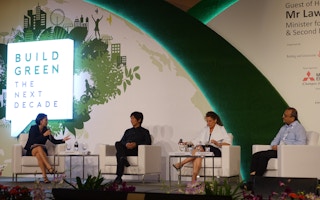Leading minds of the building and construction industry peered into their crystal balls on Wednesday at the International Green Building Conference (IGBC) in Singapore as they discussed the challenges and opportunities that awaited the green building sector in the next 10 years.
The conference, themed “Build green: the next decade” was opened by Singapore’s Minister for National Development Lawrence Wong at the Marina Bay Sands Expo & Convention Centre.
In his opening address, Wong set the tone by reminding the audience that buildings account for a quarter of all greenhouse gas emissions in the country, and highlighted three areas in which Singapore needs to improve on when it comes to green buildings.
The first is to “step up green building efforts as part of the overall global effort to tackle climate change”, which Wong said is one of the biggest, longest-lasting challenges for humankind.
The second is to continue investing in research and development, and harness technology such as big data, to improve green building performance.
Third, he highlighted the importance of educating the population, especially the young, on the need for sustainable lifestyles and green buildings.
“Buildings are only as green as the people living in them. Technology cannot overcome human habits,” Wong said.
The minister also took the opportunity to share the Building and Construction Authority’s (BCA) improved approach to its third Building Energy Benchmarking Report.
BCA widened the scope of this year’s report and published anonymised energy usage rates of healthcare facilities as well as tertiary and private education institutions for the first time.
The first and second editions of the annual report had focused only on commercial buildings and BCA eventually aims to expand reporting to other building types, including places of worship, it said.
BCA also aspires to make reporting mandatory for all buildings “in the next few years”, said Dr John Keung, chief executive officer of BCA in a press release.
Besides that, the regulatory authority launched its revamped Green Mark scheme for residential buildings on Wednesday with a year-long pilot, with new criteria on top of existing ones that measure energy and water efficiency. This to encourage building designers to focus on good passive design, facade performance, and effective natural ventilation at the planning stage.
IGBC kicked off its packed roster of panel discussions with a leadership plenary entitled “Can we do better than 2 degrees?” in reference to the 2 degree Celsius cap on global temperature rise agreed upon at the United Nations climate summit last year.
Moderated by Eco-Business editor Jessica Cheam, the discussion featured speakers who elaborated on how best to reduce the emissions of the building sector.
Romilly Madew, chief executive officer of the Green Building Council of Australia, said collaboration between stakeholders including government and industry was key, and credited Australia’s strong performance in the Global Real Estate Sustainability Benchmark report - also released on Wednesday - to this.
On the other hand, World Green Building Council chair, Tai Lee Siang, believed that incremental improvements would not be enough and the focus should really be on “significantly reducing our energy consumption in all ways” and suggested a paradigm shift in urban planning. As examples, he pointed out that a lot of energy is wasted on roads and unoccupied buildings.
“
Buildings are only as green as the people living in them. Technology cannot overcome human habits.
Lawrence Wong, Minister of National Development, Singapore
The third panellist was Professor Subodh Gautam Mhaisalkar, who is Tan Chin Tuan centennial professor at the School of Materials Science & Engineering as well as executive-director at the Energy Research Institute @ NTU (ERI@N), Nanyang Technological University.
He said society could become more sustainable by focusing its efforts on addressing user behaviour and harnessing new technologies.
Another concern among the audience was whether it was possible to make existing buildings net zero, especially given the footprint existing cities already have.
Madew said the technology to do that is there, though various factors - not least money - also play a role.
Mhaisalkar agreed, saying: “Going for net zero is an honourable goal, but it should be balanced against what it would cost.”
He said net zero might be “challenging”, but there was still the possibility for reducing energy consumption of buildings at the very least.
IGBC runs until Friday, September 9 and is expected to see a turnout of over 1,000 participants including green building experts, government representatives, and academics, from over 30 countries.
Eco-Business is producing a special e-newsletter featuring stories on the proceedings at IGBC 2016, kindly supported by City Developments Ltd and the Building and Construction Authority. Sign up to receive the newsletter here.















